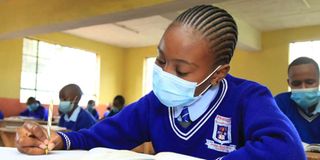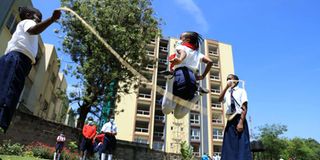No more KCPE, KCSE exams in changes to the education system

Agnes Muthoni, a Class Eight pupil at Nyamachaki Primary School in Nyeri, undertakes her studies on October 12, 2020.
What you need to know:
- Assessment will be through cumulative continuous assessments beginning in Grade Four and a summative examination in Grade Six.
- Pupils will move to secondary school after Grade Six
A whole new world in the education system was unveiled yesterday, putting to rest questions that have lingered on since the Competency Based Curriculum (CBC) was rolled out in 2019.
The state will expand all public secondary schools to host learners in Grades Seven, Eight and Nine, which will also see the merger of primary schools left with low enrolment figures, as authorities resolved one of the key concerns about the new system.
The details regarding the structure, policies and implementation of the CBC, which is a complete departure from the 8-4-4 system that has been in place for over 35 years, are contained in a task force report launched yesterday in Nairobi by President Uhuru Kenyatta.
He described it as “a turning point in our education system.”
Learners transitioning from primary school will no longer sit the Kenya Certificate of Primary Education (KCPE) examination, which has been in place since 1985.
Assessment of learning
The pupils currently in Standard Five will be the last group to sit the exam in 2023, marking an end to one of the most iconic moments in the lives of millions of Kenyans. In the new structure, learners will also join secondary school at a much younger age but spend more years at that level.
Their assessment of learning will be determined by their scores in cumulative continuous assessments beginning in Grade Four and a summative examination in Grade Six.
Learners will undertake assessments weighted at 20 per cent in Grade Four, Five and Six and then another one weighted at 40 percent at the end of Grade Six to make a score of 100 per cent. The assessment tools will be developed by the Kenya National Examinations Council (Knec).

President Uhuru Kenyatta hands over a taskforce report on Enhancing Access, Relevance Transition and Equity and Quality for Effective Curriculum Reforms Implementation to Nyeri Governor and Council of Governors Education Committee Chairperson Mutahi Kahiga (left) during official launch of the report at an event held at the Kenyatta International Convention Centre on February 9, 2021.
Whereas the continuous assessments will be school-based and scored by teachers, the summative one will be at the national level.
“The summative assessment is prompted by the need to allow learners from across the country to access schools which have superior infrastructure and a culture of good performance, thus enhancing equity,” the report reads. It is their performance in these assessments and the interest of the learners that will be used to place learners in junior secondary school.
Junior secondary school
The report by the CBC implementation task force has recommended that all 10,359 secondary schools will host junior and senior sections, resolving one of the questions around the 2-6-3-3-3 structure.
The team that was appointed in June 2019 was led by Prof Fatuma Chege, the deputy vice chancellor, administration, at Kenyatta University. There is, however, a provision for junior secondary schools only, especially for private schools, which may wish to invest only for this level.
The same will apply for senior secondary schools. Private schools will also be allowed to establish a “whole school, running from pre-primary to senior secondary school.”
To take care of the new learners, the report recommends a “progressive expansion of capacities of existing secondary schools that have adequate land to accommodate more learners.”
Primary schools that have adequate infrastructure will also be supported to establish a junior secondary school while those that are under-enrolled and in close proximity to each other will be merged and the infrastructure in one of them improved to create a junior secondary school.
Career paths
In the three years of junior secondary school, learners will be exposed to 12 core subjects as well as optional ones.
They are expected at this point to have identified their areas of interest before choosing subjects that will help them pursue their dream career paths in senior secondary.
Placement to the senior secondary schools will also be based on cumulative continuous assessments and summative assessments and the learners’ career choice. Senior secondary provides three pathways — arts and sports science, social sciences or sciences, technical engineering and mathematics (STEM). Each of the pathways will have various individual subjects.

Grade Four Pupils of Parklands Baptist School play during break time on November 19, 2020.
The task force has recommended that all senior secondary schools will host at least two pathways “for optimal utilisation of resources.” This is in anticipation that schools will require heavy investment especially in STEM for effective teaching of the pathways.
The pathways are intended to make learning meaningful with the students dropping subjects they are not interested or gifted in to concentrate on what they can do best.
Seamless transition
Schools that will be deemed to have the capacity to host all the three pathways will be identified and their infrastructure progressively enhanced. It is expected that these will most likely be the existing extra-county and national schools which already have advanced facilities like laboratories, workshops, music rooms and equipment and sports facilities.
“The existing 35 special needs education secondary schools will be designated to cater for both JSS and SSS for tracks that the respective SNE learners can pursue in the three pathways,” the report recommends.
The Teachers Service Commission will be expected to prepare projections on teacher requirements for reforms in senior secondary school. The commission has since 2019 trained over 150,000 in primary schools at a cost of Sh1.8 billion.
With learners having specialised in their preferred pathways, the architects of the CBC anticipate a seamless transition to technical and vocational education and training (TVET). There are ongoing reforms in the sector also to closely align it to the CBC.
The first cohort of CBC will transition to university in 2029. The task force recommends that the Commission for University Education fast-tracks the development and review of university programmes to align them with the three pathways offered in senior secondary school. Lecturers in universities will also be trained to fit into the CBC approach.





